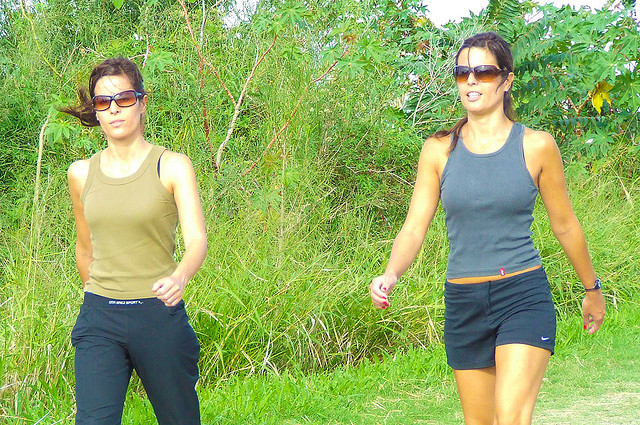Get Off to a Great Start in Your New Fit Lifestyle by Taking These Six Easy Baby Steps That Will Have You Looking, Feeling, and Performing Better Fast

Baby steps.
That’s all that’s standing between you and your goals. And when it comes to improving your health, fitness, and quality of life, they work better than any other strategy I’ve tried. This short guide will give you six great ones to get started with.
So, if you’re not 100% satisfied with your health and fitness – if you’d like things to be a little different, or if you’d like to get a little more out of your efforts – baby steps are what you need. This is one of many different names for the simple process of making gradual, incremental changes to bring about a certain desired result.
Professionals use them. And newbies who are in the know use them, too. And it’s because they work. The truth is that if you’re not taking baby steps toward your goals, you’re probably not going to succeed.
So, if you’re looking for a way to get started (or restarted), or if you want to take things to the next level, you can begin your journey towards better health, fitness, and a higher quality of life – starting today – with these strategies that are both simple and easy.
Baby steps are the building blocks of both short-term success and long-term mastery. And get this. Each of these baby steps will actually help you look, feel, and perform better. They offer a phenomenal return on your investment, and you’ll be amazed at the impact they can have.
So, don’t underestimate the power of these simple habits because they will make a big difference and will pave the way for future success.
1) Start Drinking Water at Least 90% of the Time.

This is perhaps the simplest, easiest, and most logical step towards improving your health, fitness, and quality of life. So, don’t overlook it simply because it seems braindead obvious. Staying hydrated with good, clean water is critically important and it affects everything. Even a few hours of dehydration will impact how you look, feel, and perform. Not to mention that going a few days without water is usually fatal.
And given that most people are chronically dehydrated – whether they know it or not – this seems like a good place to start. And the best part is that this task couldn’t be any easier, especially if you approach it gradually (rather than going cold turkey).
How to start: First, figure out your ideal water intake (approximately) and develop a system to drink that much each day. For instance, I have a special glass that I use at home, and I know that I need to drink at least 8 glasses of it to hit my daily requirement. Some people use a specific water bottle. Others, carry around a gallon of water everywhere they go. Whatever you decide, keep it simple.
Then, gradually cut down on unhealthy beverage choices (alcohol, soda, juice, energy drinks, etc.) by replacing one non-water beverage with a glass of water. So, if you normally drink a coffee and some juice in the morning, a soda at lunch, a mid-afternoon coffee, and a beer or glass of wine at dinner, swap out one of those for a water. In other words, if you drink three unhealthy drinks per day, on average, try doing just two per day for a couple of weeks. Then cut down to one per day. And repeat this process until you’re drinking water for at least 90% of your liquid intake. When you’re down to one unhealthy beverage per day, you can either eliminate them completely or reserve them for special occasions (e.g. special events, planned cheat meals, etc.).
Note: some other beverages are perfectly healthy to drink in moderation, like green tea and black coffee, for instance. And there are plenty of ways to spice up water (e.g. with a slice of lemon, lime, mint leaves, etc.).
2) Sleep Better Every Night.

Sleep is the perhaps the most important and also the most overlooked factor in living a healthy lifestyle. Nowadays, it’s treated like a commodity, instead of a necessity. People even like to joke saying, “I’ll sleep when I’m dead.” You’re right about that! In fact, research has shown that you’ll probably be dead much sooner than you think if you don’t sleep enough. Not to mention that being sleep-deprived will wreak havoc on your health, fitness, performance, and quality of life, among other things.
Now, most people rationalize that they can do just fine with less sleep. “I’m fine,” they’ll say. And they’ll probably claim that they don’t have enough time or say “I’m too busy to get a good night’s sleep.” But they’re dead wrong. The truth is that you’re too busy NOT to sleep!
The research is overwhelmingly clear. A lack of sleep negatively affects everything in the short and long-term. And getting enough quality sleep improves everything about your life.
In fact, most people find that once they start getting enough sleep, they’ll start thinking, “I didn’t know I could feel and perform this well.” Or, “I didn’t know that sleep had such a powerful effect.” The truth is that you just won’t know how great it is until you experience it for yourself. And if you really think that you’re fine without enough sleep, research has shown again and again that you’re deluding yourself! You’re wrong.
So, if you want to be healthy, fit, and perform at your best, getting enough quality sleep absolutely must become a top priority of yours. The good news is that it’s pretty easy to implement once you have your priorities straight.
How to start: Figure out how much sleep you need. 7-9 hours a night is the recommended minimum for the vast majority of adults. Depending on who you are, you may need 7 or 9 hours each night. So, 8 hours of quality sleep a night is a good goal to work towards. You can adjust things later, if necessary. So, figure out what time you need to get up (and when you need to go to bed to get enough sleep), and then set an alarm for when it’s time to get ready for bed. You may need to gradually work your way there over a week or two if you’re used to staying up late.
Having a night-time ritual to help you wind down and setting your sleeping environment up for optimal sleep will help, too. There is plenty of great information available online about setting yourself up for sleeping success.
And hey, I don’t want to hear any excuses or complaining because telling you to sleep more isn’t all that different from telling you to have more sex. And who wouldn’t want that?
Note: I have an in-depth post on improving your sleep drafted – been researching and working on it for awhile now. So, if you’d like to make sure you don’t miss it, please signup for the newsletter, or follow me on Facebook or Twitter for daily updates.
3) Eat at Least One Serving of Vegetables at Every Meal.

If there’s one thing that Americans need to eat more of, it’s plants. Your grandma knew best when she told you to “eat your vegetables.” Vegetables are nutrient-dense, and yet, low in calories. They’re high in vitamins, minerals, and fiber. They’ll help you prevent disease (and fight disease). And depending on how they’re prepared, they make a great main dish, side dish, appetizer, or snack.
If you believe that you just “don’t like vegetables,” then in my opinion, you probably just haven’t tried hard enough. Believe me, there are ways to prepare veggies that you will enjoy. You don’t have to force-feed or deprive yourself.
How to start: Make a list of all the vegetables you like to eat, and if applicable, how you like to eat them (e.g. raw, cooked, in a salad, with dip, etc.). So, don’t think, “I should eat broccoli because it’s good for me.” Instead, think, “I like carrots. So, I’ll get some for my afternoon snack. Maybe I’ll find some tasty hummus for dip, too.” It sounds simple, but re-framing your mindset in this way can make a big difference.
Then make a simple meal plan (doesn’t have to be perfect) on what and when you’ll be eating them. Don’t go crazy here because it doesn’t have to be perfect. I’d recommend getting some veggies that you’ve planned to eat with certain meals (e.g. red and green peppers with breakfast, spinach with lunch, broccoli with dinner, etc.), and also some veggies that you can grab for a snack or a quick side dish (i.e. ideally, something you enjoy raw so that it’s convenient). Get your veggies wherever it’s most convenient (e.g. grocery store, farmer’s market, etc.). And then start munching!
And for right now, don’t worry too much about if they’re fresh, frozen, canned, etc. Just start by eating at least one serving of vegetables at every meal. You can change things later (remember, baby steps!). If you find that your list of veggies is really short – like you only enjoy broccoli and carrots, for instance, try researching some ways to spice them up a bit. And consider trying a new veggie each week. Look up a recipe online that has a lot of positive reviews. And then do whatever you need to do to try and enjoy them (that’s the key). So, for now, go ahead and put some butter, cheese, dressing (etc.) on those things if you’d like.
Eventually, you can start tweaking your nutrition for optimal health and fitness results. And for that, I recommend this excellent book.
4) Do a Little Bit of Exercise Every Single Day.

Physical activity is the fountain of youth. And a little bit of exercise daily is one of the best investments you could ever make for your health and fitness. And you don’t need an extremely complex plan or long, intense workouts to get some of the benefits. So, getting into the habit of exercising daily is one of the best things you can do for yourself. Eventually, you may want to graduate to a more formal training program. But for now, it’s the daily habit that matters most.
Training, nutrition, and recovery form three of the cornerstones of excellent health, fitness, and quality of life. And when you integrate all three together, great things start to happen. So, make this a priority.
How to start: If you have not ingrained the habit of daily exercise, then select one activity that you can and will do every day – and preferably, something that you will enjoy doing. And commit to doing the bare minimum of that one activity. It could be as simple as a short walk, one set of pushups or squats, or trying a new yoga pose each day.
There are tons of options out there, and there are plenty of ideas on this site if you search through the Archives. So, ask yourself what you’d like to do – something that would be fun – and start with that.
In the beginning, it’s really important that it’s simple and easy for you. So, if it were me, I’d say the best thing to do would be going for a daily walk. This is the simplest, easiest thing you could do that will pay off in dividends – and not just physically.
Here’s how I made a habit of walking daily: Easy Walking Program.
5) Manage Stress With Box Breathing (aka Square Breathing).

As a culture, we are majorly overdosed on stress. And most of us don’t have the slightest clue how to deal with it. Box breathing is one of the simplest tools you can use to start managing stress. The best part: anyone can do it, it’s free, and it works instantly.
How to start: First, take three minutes to learn the technique here: How to Relieve ANY Type of Stress and Relax Yourself Instantly With This Simple Breathing Trick. Then use liberally whenever you can for periods of anywhere between 1-20 minutes (depending on your time availability and needs). One minute will usually be long enough to derive some of the benefits and get a noticeable boost. Three to five minutes would be better, and is likely all that is necessary in most cases. And 10-20 minutes may be necessary in some extreme cases.
Some good times to use it would be:
- whenever you’re feeling overwhelmed or stressed out – even 1 minute of box breathing will help!
- during a morning quiet time to get you focused and ready to rock your day
- prior to a workout or some other stressful event (e.g. job interview, meeting at work, conflict resolution, etc.)
- after a workout or other stressful event to quick-start recovery (I usually do it during corpse pose at the end of my yoga)
- prior to bed to help you wind down and fall asleep
Note: after you’ve gotten the box breathing down, you can integrate this with some meditation or visualization exercises (among others) for additional benefits (I recommend this book, which has some good drills and exercises, to help you get started: The Way of the SEAL). Remember, box breathing is just one baby step. There are many other ways to manage stress, and I recommend that you learn at least a few of them.
6) Take One Small Step to Stop Destructive Behavior.

Sometimes, one little thing can undermine an otherwise healthy lifestyle. Smoking is a good example, but there are many other things, too. Maybe it’s just a tendency to have one too many drinks. Or, to eat/drink impulsively, rather than mindfully. Maybe it’s an addiction to sugar, alcohol, processed foods, etc. It could be sitting down in a chair all day long.
But destructive behaviors are not always things that we consider health-related. It could be materialism, doubting yourself, or resisting change, just to name a few. It could even be something as simple as negative thoughts (e.g. I can’t, I’m not worth it, I’m a failure, etc.). The point is that most of us have some things that we should stop thinking/doing/believing. And you know what those things are better than anyone else.
How to start: Get honest with yourself and identify exactly what you need to work on. If it’s many things, pick just one to focus on. Then, select one distinct change that you’re going to make – a baby step – and commit to it completely. Having some accountability and social support – in any form – will help immensely!
Whatever you decide to do, set yourself up for success, and have a plan for if you fail. Better yet, expect to fail, and be ready to keep going when that happens. Sometimes, destructive thoughts or behaviors can be overcome quickly, and sometimes, it can take years. That’s why baby steps are so critical.
How To Get Started
So, I’ve thrown a lot at you already. Not only are there six habits listed above, but each one leads into a whole sea of new possibilities. For example, eating more vegetables is just one of many steps towards better nutrition. So, I wouldn’t blame you if you’re feeling a little overwhelmed right now.
And guess what? There’s a solution for that, and it’s called baby steps.
Just like Rome wasn’t built in a day, excellent health and fitness won’t happen overnight either. It’s takes time and a lot of practice.
So, you can either work your way through the list from first to last. Or, choose the most important task that you think will make the biggest difference for you, personally, and commit to mastering that one before moving on to anything else. Or, if you suspect that you’ll have a hard time with any of these tasks, start with the one that will be easiest for you. Maybe that’s Box Breathing or just gradually drinking more water. It doesn’t get much easier than that.
And after you’ve gotten these basics down, you can start to build off of the foundation you’ve created by going a little deeper into these areas (e.g. focusing on getting your exercise and/or nutrition up to par).
You’ll be off to a great start once you have these habits in place.
You’ve got this. So, get to it! And please share this post if it was helpful for you!
If you found this article helpful, please share it with your friends:
.jpg)
![]()
Health-First Fitness Coach
P.S. If you liked this post, then please signup for the newsletter, or follow me on Facebook or Twitter for daily updates and other interesting info.
Nice going i will share this to face book … So cool John :)
Thank you, Aniana!
Thank for this post. It was very helpful. I will definitely share this.
Thanks, Big Jon!
Thank you! Most of these type of posts are the same information regurgitated. Yours is very practical and I can tell your tips come from real life experience.